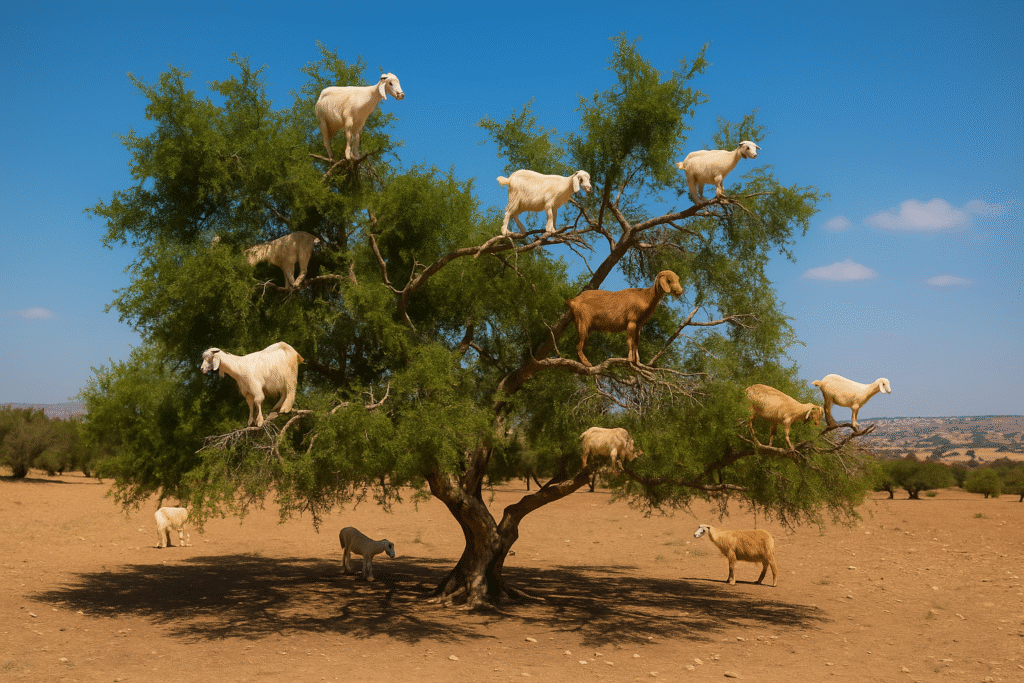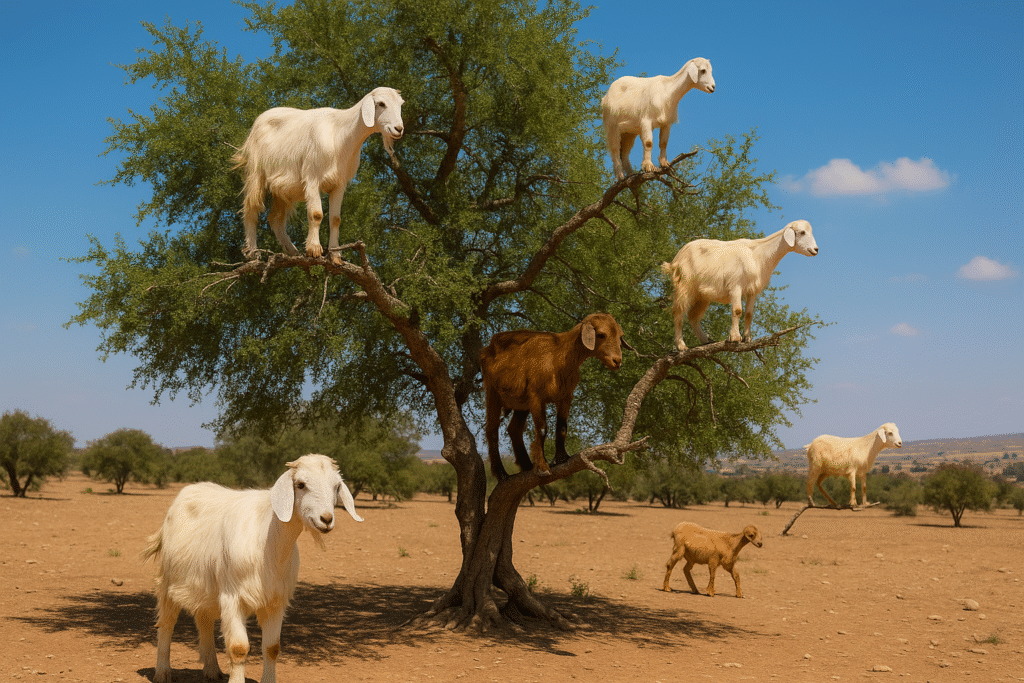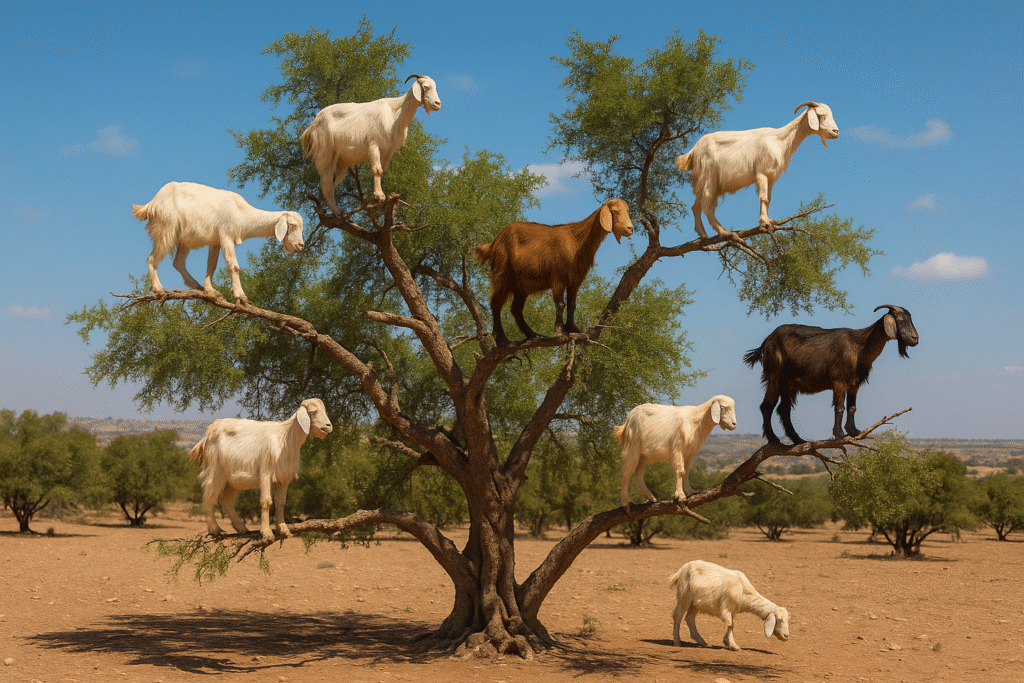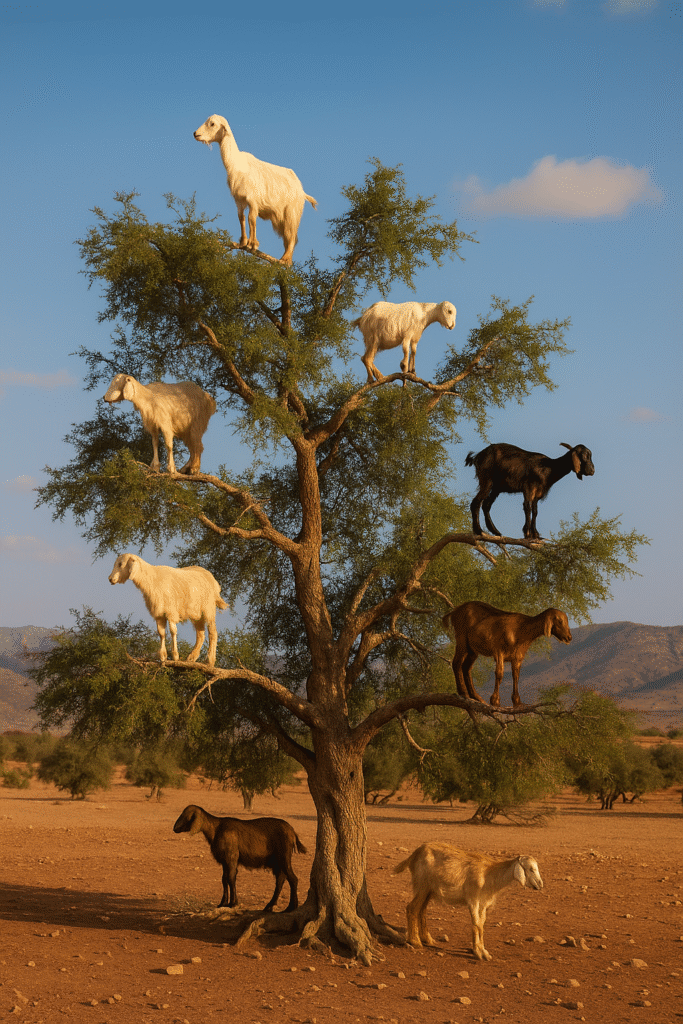Prologue: a thorny crown full of hooves
On the tawny plains of southwest Morocco, a single tree twists out of the earth like green lightning. Its branches are gnarled, armored with thorns, and—improbably—dotted with goats. They balance like gymnasts, nibbling leaves and pecking at oval fruits, eyes level with the horizon. This is the argan tree (Argania spinosa), an ancient survivor of heat and drought. Around it stretches the Arganeraie, a cultural landscape where trees, goats, and people have practiced a three-way partnership for centuries. From these thorny crowns comes one of the world’s most prized oils—argan oil—and one of travel’s most surprising sights.

1) The Argan Tree: Anatomy of a Survivor
Endemic to Morocco, the argan tree is a botanical specialist for hard country.
- Deep resilience: A massive taproot plunges toward hidden moisture, while lateral roots knit sand and gravel into living scaffolding.
- Evergreen armor: Small, tough leaves reduce water loss; dense, twisted wood resists wind and burning sun.
- Fruit & nut: Each yellowish fruit encloses a stone so hard it can dent metal; inside that stone sit one to three almond-like kernels—the source of argan oil.
- Age & range: Many trees live for centuries. Their heartland runs from Essaouira through Taroudant and Agadir into the Anti-Atlas, an ecosystem recognized as a UNESCO Biosphere Reserve.
The argan tree is more than a plant; it is rural infrastructure. It shades soil, slows erosion, feeds animals, anchors farms, and gives villages an export with global name recognition.
2) Why Goats Climb Trees
Moroccan goats climb argan trees for three simple reasons: food, practice, and tradition.
- Seasonal menu: In late spring and early summer, trees offer tender leaves and ripening fruit. Goats are natural browsers with split hooves and excellent balance; a leaning trunk or low branch is an invitation.
- Learned behavior: Kids follow their mothers into the canopy, copying routes and perches the way young mountain goats learn cliffs.
- Pastoral rhythm: Herders time daily circuits to browse trees selectively, then move on so groves aren’t stripped bare.
The sight looks like a magic trick, but it’s ordinary life here—a method honed by people who read the landscape with livestock, season by season.
3) Myth, Marketing, and the Goat–Argan Connection
A popular story says argan oil exists thanks to goats that eat the fruit, digest the pulp, and pass the nuts, making them easy for people to gather. There is some truth—goats can disperse seeds, and villagers have long collected fallen stones—but modern argan oil does not rely on goat digestion. Today, fruit is harvested from the ground or pruned branches, sun-dried, and the stones are hand-cracked or mechanically processed to extract kernels.
Another wrinkle: along busy roads, you may see crowded goats in a single tree at odd times of year. Often those goats have been placed there for photos. The goats aren’t harmed when handled by experienced herders, but staged scenes can lead to overloaded branches, soil compaction, and stress if repeated constantly. Ethical operators limit time, numbers, and trees—and many regions now discourage staging altogether. The real behavior is best seen at a distance, early summer, when scattered animals browse calmly across a whole grove.

4) From Fruit to Bottle: How Argan Oil Is Made
The oil’s value comes from scarcity, labor, and chemistry. One tree makes modest fruit; many kilograms of dried fruit are needed for a single liter of oil. The process—still surprisingly hands-on—goes like this:
- Collect & dry. Fallen fruit is gathered and sun-dried to loosen pulp.
- Pulp removal. The leathery flesh is rubbed off by hand or machine.
- Stone cracking. The ultra-hard nutshell is cracked—traditionally with two stones—to free the pale kernels. This step is skilled labor, historically done by women.
- Roasting (culinary oil only). Kernels for food oil are lightly roasted to develop a nutty aroma; cosmetic kernels remain raw.
- Grinding & pressing. Traditionally, a hand-turned stone mill produced a paste that was kneaded to release oil. Modern cooperatives use cold-press machines that improve hygiene and yield while preserving nutrients.
- Decanting & filtering. The oil rests, then passes through filters to remove fine solids. No solvents; no high heat.
Two products result: culinary argan oil, amber with roasted notes for tagines, couscous, salads, and the beloved amlou (argan oil, almonds, honey); and cosmetic argan oil, lighter in aroma, prized for skin and hair.
5) What Makes Argan Oil Special (The Chemistry, Plainly)
Argan oil’s reputation isn’t just marketing. Its composition is a strong fit for both diets and skincare:
- Fatty acids: Rich in oleic and linoleic acids—similar to olive and some nut oils—supporting heart-smart cooking and skin barrier function.
- Tocopherols (vitamin E): Naturally high; helps stabilize the oil and provides antioxidant benefits on skin.
- Sterols & squalene: Minor components thought to support suppleness and moisture retention.
- Smoke point: Culinary argan oil is best for finishing and gentle sauté rather than deep-frying; heat lightly to keep flavor and nutrients intact.
Quality matters. Authentic oil should be single-ingredient, cold-pressed, with a harvest or pressing date and a clean, nutty (culinary) or faintly green (cosmetic) aroma.
6) Women’s Cooperatives: Economics with Roots
The global hunger for argan oil brought money to rural Morocco—but not automatically to the households doing the work. Beginning in the 1990s, women’s cooperatives transformed the economics:
- Fair pay for skilled steps like cracking, sorting, and pressing.
- Literacy and accounting programs tied to co-op membership.
- Quality control that rewards careful fruit selection and hygienic handling.
- Community investment in wells, clinics, and school supplies when profits exceed costs.
When you buy verified co-op oil, you purchase method + livelihood, not just a trendy ingredient. The bottle is an address: it points back to Souss-Massa valleys where families keep trees alive because trees keep families alive.
7) Ecology: A Tree That Holds the Land
Argan groves are working landscapes with ecological muscle.
- Erosion control: Roots knit fragile soils, buffering flash floods and wind.
- Biodiversity: Groves shelter birds, pollinators, and herbs under a dappled canopy.
- Microclimate: Shade and organic matter nudge temperatures, moisture, and microbial life toward stability.
- Carbon: Old trees store carbon in dense wood and in the soil they stabilize.
Threats are real: overgrazing, fuelwood cutting, urban sprawl, and drought stress the system. Traditional management tools—seasonal closures called agdals, rotational browsing, and respect for seedling “nurseries”—remain the best fixes when matched with modern monitoring and water savvy.
8) Culture & Calendar: A Living Heritage
Argan is more than a commodity; it is identity. The tree appears in proverbs, wedding cuisine, medicinal recipes, and morning bread. There is even a global day for it: the International Day of Argania (10 May)—a reminder that a local tree now stands on an international stage. Visit villages during harvest and you’ll hear the gentle clack-clack of cracking stones, a sound as much a part of the landscape as wind in the thorns.
9) Responsible Travel: See the Goats, Help the Groves
If you come to photograph the famous climbers, do it in a way that pays the future:
- Time it right. Natural browsing peaks in late spring–early summer; scattered goats across many trees signal the real thing.
- Read the scene. Too many goats in one tree, in midday heat, out of season, beside a tour bus pull-out? That’s staging.
- Pay for produce, not perches. Buy local fruit, almonds, honey, or verified co-op oil rather than tipping for risky photo ops.
- Stay on paths. Soil under argan trees is easily compacted; roots need breath.
- Ask about agdals. If a grove is closed for regeneration, respect it—closures are how trees recover.
10) Quick Guide for Editors & Curious Travelers
Where: The Arganeraie of southwest Morocco—Essaouira, Agadir, Taroudant, Anti-Atlas foothills.
What you’ll see: Low, broad trees with knotted trunks; seasonal fruit; goats browsing or, occasionally, perched.
What to eat: Amlou at breakfast; culinary argan oil as a finishing drizzle on couscous, roasted vegetables, grilled fish.
What to bring home: A small, fresh bottle of cold-pressed oil from a reputable cooperative; store cool and use within a year.
What to remember: The tree is slow, the landscape is fragile, and a good photograph is one that leaves no trace.

11) FAQ (fast answers for common questions)
Do goats really climb trees?
Yes. Browsing goats routinely climb argan trees to reach leaves and fruit, especially when pasture is sparse and fruit is ripe.
Is argan oil made from goat droppings?
No. Modern production uses dried fruit and hand-cracked stones. Goat digestion is neither necessary nor desirable for quality control.
Why is authentic oil expensive?
Because it’s scarce, labor-intensive, and made from kernels locked in extremely hard stones. Quality producers also pay fair wages and follow careful hygiene.
Culinary vs cosmetic—what’s the difference?
Culinary oil is lightly roasted and filtered for flavor; cosmetic oil is raw, cold-pressed, and often filtered more finely. Both should be pure and fresh.
Are staged goat photos harmful?
They can be, if trees are overused or branches overloaded. Favor natural sightings and ethical guides.
12) Closing: A Landscape in a Spoon
Swirl a little argan oil on warm bread and you taste a place where trees hold the ground, goats read bark like a map, and families turn patient labor into something golden. The flavor is roasted almond and dry wind, shade and grit. It is the taste of a working alliance—tree, animal, human—that has outlasted droughts and dynasties. Protect the alliance, and the goats will keep their high perches, the soil will stay put, and the bottle on your table will always be a short story from Morocco, told in oil.



Reply